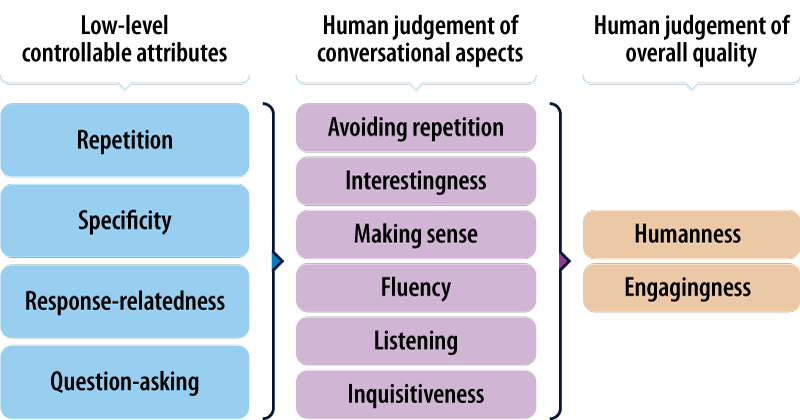Rise of the chatbots
People like to chat. It’s one reason that WhatsApp users share an astounding 65 billion messages per day.1 Chatting is a more natural and personal way to exchange information. But for a business, providing this at scale to customers is difficult. This is driving many businesses, including banks, toward developing digital chatbots that improve customer service by increasing the volume and speed at which they can provide personalized information.
Whether it’s booking tickets, paying bills, answering FAQs, obtaining product information, managing complaints, marketing or lead generation, chatbots are popping up everywhere. Retail sales from interactions with chatbots are estimated to reach $112 billion by 2023, according to Juniper Research.2 Chatbots are a great business tool for many reasons. They are available 24/7, automate repetitive tasks, answer simple questions instantly and manage multiple customer requests simultaneously.
They are also cheap to build and can scale without significant additional investment. It can take a matter of months to build a chatbot, depending on the complexity. According to Guruprasad NV, a senior principal architect from the Infosys Center for Emerging Technologies (iCETS), “Chatbot technologies have evolved rapidly over the past few years. We can now develop simple production-grade bots in less than four weeks; however, complex ones can take a little longer and will evolve over time.”
Banks have led the charge in embracing chatbots, as this industry is rife with transactional tasks that can be automated. Chatbots resolve customer queries on personal finance, capital management, financial advisory, payments, money transfer, credit scores and more. After the financial crisis, chatbots also have begun to target the main part of a bank’s business by becoming “robo-advisors.” These chatbots help consumers choose investments and manage their finances. And because regulatory compliance can be programmed into a chatbot, it is hoped that a reduction in human bias and conflict of interest will result.
“Chatbots are used across different banking services”
Regardless of their purpose, chatbots are expected to help banks save an estimated $7.3 billion in operational costs by 2023, according to Juniper Research. This represents 862 million hours of time saved for banks in 2023.3
Figure 1: Simple ways banks benefit from the use of chatbots
| Use case | Chatbot | Example | |
|---|---|---|---|
| 1 | Internal help desk | Aida | Aida, SEB Bank’s internal IT help desk chatbot, supports nearly 15,000 employees and handles queries on network connectivity, firewall support, ordering of supplies, meeting bookings and troubleshooting of business applications.4 |
| 2 | Self-service | COIN | JP Morgan’s COIN (Contract Intelligence) automates document review and extracts data. COIN can review approximately 12,000 documents in seconds, versus 360,000 hours of work that a human would spend on the same documents. The algorithm is considered more accurate than humans are.5 |
| 3 | Financial assistant | Erica | Erica, Bank of America’s virtual assistant, assists customers in completing transactions and paying bills. It checks and plans payments, orders transfers between accounts, blocks a credit card if necessary or sends money.6 The chatbot has acquired 7 million users and completed over 50 million client requests.7 |
| 4 | Integration with social media | BMO Bolt | Through Bank of Montreal’s chatbot, BMO Bolt, customers can get information in areas such as daily banking, credit cards, mortgages and online banking via Facebook Messenger or Twitter.8 |
| 5 | Capital management | Cleo | Cleo connects bank cards to the messenger of choice, through which customers can pay bills, transfer money and perform other instantaneous transactions. Cleo helps plan budgets, save money and track spending.9 |
| 6 | Financial advisory | Plum | Accessed through Facebook Messenger, Plum helps customers save money in small increments. After the initial registration, Plum is connected to the customer’s bank account. It analyzes the customer’s income and spending history and predicts how much the customer can afford to save. Small amounts are deposited to the Plum savings account, with periodic reporting.10 |
| 7 | Shopping assistant | Eno | Capital One’s Eno allows customers to text and pay bills instantly, receive their account balance, and shop without credit cards. Eno creates unique virtual card numbers for each merchant site from a web browser extension and makes the site easier to access and quick to use.11 |
Source: Infosys research
Chatbots aren’t perfect — yet
Chatbots have a long way to go before they achieve their full potential, and several challenges have to be overcome. Perhaps it shouldn’t be surprising that, given all the bold forecasts for growth of this technology, in 2018 Gartner listed chatbots as entering the “Peak of Inflated Expectations” phase of evolution in its Hype Cycle for CRM Customer Service and Customer Engagement.12
In fact, despite all the investment in developing chatbots, it’s not clear that people prefer to use them when given the choice. Only 13% of people used a chatbot to communicate with a business in the last 12 months, according to research in 2019 from Drift, a company that focuses on conversational-marketing technology. This compares with 65% of people who have used email and 55% who used the telephone.13
The biggest challenge to overcome is simply that chatbots are not yet convincing as a replacement for human interaction. Their design is based on conversation trees rather than true artificial intelligence. So if a query goes off plan or is open to broad interpretation, the customer has to be handed off to a human respondent. Their effectiveness is also limited by the data they have access to. So while building a chatbot can be cheap, integrating all the systems and knowledge behind the scenes to effectively support the chatbot can be more complex.
They can also lack an ability to understand conversational context, interpret nuances in speech and empathize with the customer. Research by Spiceworks showed that 59% of organizations using chatbots found they misunderstand requests.14 Similarly, the same percentage feel chatbots misunderstand the nuances of human dialogue. And 30% of companies find that chatbots execute inaccurate commands, while 29% find that they have difficulty understanding different accents.15
There are also fears that chatbots can open a new door to fraudsters and cybercriminals. An infamous example is Ticketmaster’s support chatbot, which was breached when poorly designed JavaScipt on its payments page allowed data to be stolen. This impacted nearly 4,000 U.K. customers in 2018.16
Finally, chatbots are only as good as the information they have access to and can learn from. An infamous example is Microsoft’s Twitter bot, Tay, that went live in March 2016. Designed to learn from people it chats with, the bot had to be shut down within 16 hours of its launch, as it learned politically incorrect phrases and inflammatory messages posted by its users.17
Best practices for effective chatbots
Where does this leave banks that are looking at making chatbots a core tool for customer or employee interaction? There is no doubt that there are benefits to using chatbots, but their use and design need to be carefully considered for the bots to succeed.
Choose the right use case
The key here is to choose the use cases that are not well served by other channels rather than replicate information and services that can be found easily elsewhere. A good starting point is those queries that come in by email or telephone, when users cannot find the information online themselves.
Another rich seam to mine for use cases is those interactions where the user requires speed and efficiency rather than detailed information and advice — for instance, quickly checking balances or interest rates, comparing product features, or updating personal circumstances.
Unfortunately, security and fraud concerns are a big barrier to banks in enabling more powerful use cases for chatbots, such as transferring funds, creating new payees or making investment decisions. However, these concerns can be addressed by better design and integration with verification and security systems (see below).
Map out the whole process
Before any implementation, it’s important to have your business processes mapped end to end. Define your use case and intents in such a way that they are mutually exclusive and collectively exhaustive. This will increase the ability of the chatbot to truly integrate with other systems and provide more holistic and effective service. This includes integration with the bank’s existing security and verification tools, data, and regulatory control systems.
A frustration for users is that current chatbots are limited in their functionality and must hand off to human support staff for any real business transaction. If this can be designed into the chatbot at the start, it will increase the chance that it will be well received and used by customers.
Open APIs improve function and quality
Open source and open application programming interfaces (APIs) are a crucial part of good chatbot design. APIs enable designers to access more cutting-edge technologies and functionalities that can be incorporated into the chatbot without having to design these in-house.
For instance, APIs allow chatbots to speak to humans using natural language processing, which gives a warm touch to a conversation. Information from external parties can also be gathered to form a knowledge base that can be accessed by the bot using APIs. Integration with external anti-money laundering, identity verification and voice identification technologies is also crucial in order for a bank to meet its security and regulatory needs.
Make the conversation better
It’s important to invest as much as possible in making chatbots more human. They must have access to enough information and the right systems (see above) as well as be empathetic and understand cultural nuances, such as sarcasm and humor.
A paper by Stanford University and Facebook says that a good conversation requires a balance between simplicity and detail, staying on topic and changing it, asking questions and answering them. They defined specific attributes that make a good conversation.18
Figure 2: Attributes that make a good conversation

Source: Cornell University19
Taking the time to design the conversation with this in mind will be crucial to differentiating a banking chatbot from its competitors — especially as we move into the world of “robo-advisory,” where trust and confidence in technology will be highly valued by customers.
Chatbots as the future of banking
Chatbots clearly have made their mark in the financial services industry. In the right scenarios and the right conversations, they can be much more effective than other channels. Yet for many, the jury is still out on whether they will become the preferred choice for interaction with a bank and for financial advice. Will they ever move beyond being used just for balance inquiries and other informational requests and be turned into trusted advisors and transactional tools?
Things are improving. And there is evidence that outside of financial services, people are ready to use chatbots to transact. According to Drift, 27% of adult clients in the U.S. are ready to purchase basic goods through a vchatbot, and 13% of adults in the U.S. have at least once bought expensive items using chatbots.20
Chatbots are now also being designed to bring in a conversational flavor and empathize with customers. Researchers such as Hannah Rashkin, of the Paul G. Allen School of Computer Science and Engineering, are trying to bring empathy to the utterances that a chatbot makes in a dialogue situation.21
Meanwhile, artificial intelligence researchers at Facebook are working on various projects that help chatbots be less repetitive in their answers, provide relevant solutions and even display some signs of emotion.22 Any advance in AI could help chatbots predict what customers will need based on their previous activity. This could lead to banks taking a proactive approach toward selling financial products rather than acting reactively.
Yet AI is far from simulating human intelligence. And though development of better AI will help, chatbots and AI should not be confused and are not necessarily linked. A chatbot has to be designed for a specific purpose that a customer requires.
To make chatbots most effective, banks need to start thinking about which business purposes or customer needs chatbots can address, and how they should be designed. Do banks want chatbots to solve complex queries, to build customer relations, to reinforce sales support or, because they are fast and save costs? Answering these questions will lead banks’ development of chatbots and help them decide whether they need to invest more in chatbots and deliver necessary value to customers.
References
- “WhatsApp Usage Shows No Signs of Slowing Down,” Statista, May 7, 2018
- “Chatbot Interactions in Retail to Reach 22 Billion By 2023, As AI Offers Compelling New Engagement Solutions,” Juniper Research, May 8, 2019
- “Bank Cost Savings via Chatbots to Reach $7.3 Billion By 2023, as Automated Customer Experience Evolves,” Juniper Research, February 20, 2019
- “Amelia Provides 24/7/365 Services for a Nordic Bank,” IPsoft, June 17, 2019
- “JP Morgan COIN: A Bank’s Side Project Spells Disruption for the Legal Industry,” Digital Initiative, November 13, 2018
- “Best Chatbots for the Financial Services Industry,” InteliWISE, November 19, 2018
- “Bank of America’s AI-Powered Assistant Erica, Reaches 7 Million Users,” Aithority, May 30, 2019
- “Bank of Montreal Launches AI-Powered Chatbots on Facebook, Twitter,” Financial Post, March 15, 2018
- “Bank of Montreal Launches AI-Powered Chatbots on Facebook, Twitter,” Financial Post, March 15, 2018
- “Meet Cleo Review,” Finder, April 25, 2019
- “Artificial Intelligence in Finance,” Alan Turing Institute, April 2019
- “Capital One’s Shopping Assistant Eno Can Now Dole Out Virtual Card Numbers in the Browser,” Techcrunch.com, March 10, 2018
- “4 Trends in Gartner Hype Cycle for Customer Service and Customer Engagement,” Gartner, September 10, 2018
- “2019 State of Conversational Marketing,” Drift, July 16, 2019
- “Data Snapshot: AI Chatbots and Intelligent Assistants in the Workplace,” Spiceworks, April 2, 2018
- “Data Snapshot: AI Chatbots and Intelligent Assistants in the Workplace.”
- “The Good, the Bad and the Ugly,” Netstar, July 4, 2018
- “Twitter Taught Microsoft’s AI Chatbot to Be a Racist Asshole in Less Than a Day,” Verge, March 24, 2016
- “Towards Empathetic Open-Domain Conversation Models: A New Benchmark and Dataset,” arXIV, August 28, 2019
- “What Makes a Good Conversation? How Controllable Attributes Affect Human Judgments,” arXIV, April 10, 2019
- “Chatbot Report 2019: Global Trends and Analysis,” Chatbots Magazine, April 2019
- “Can These New Tricks Fix the Disaster of Chatbots?” ZDNet, July 29, 2019
- “Can These New Tricks Fix the Disaster of Chatbots?”





